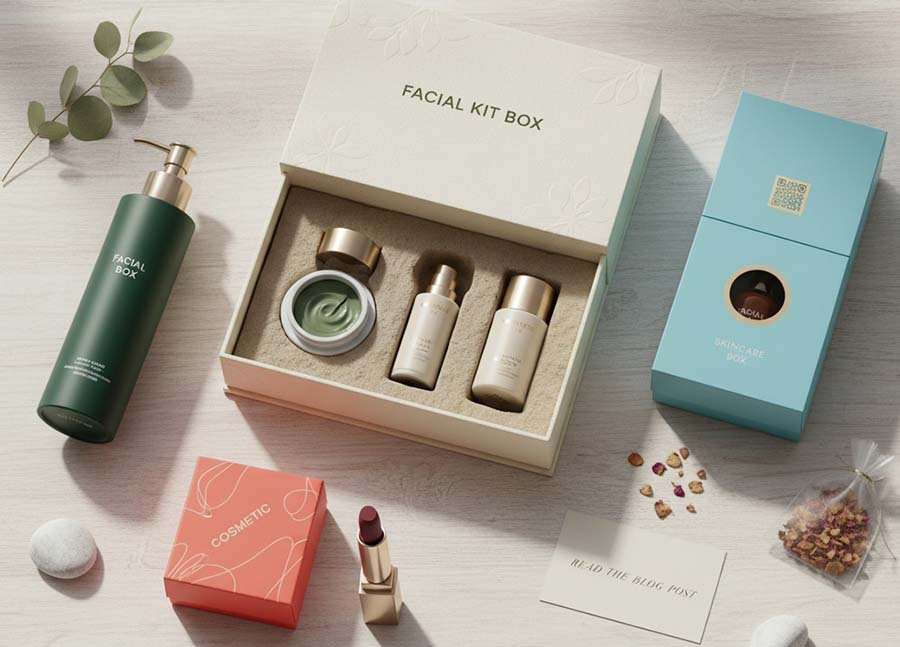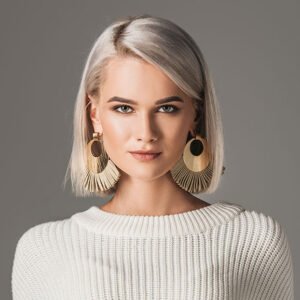
Imagine this: you walk into a beauty store. Your eye drifts across shelves packed with skincare creams, serums, facial kits, and other cosmetic items. Which ones pull you in? The ones in slick, beautiful skincare boxes, or those tucked inside plain wrappers? Chances are you reach first for the product whose beauty packaging charms you. Because when it comes to skincare and cosmetics, packaging is often the first handshake between brand and buyer.
In this blog, we’re diving into facial boxes, facial kit boxes, cosmetic boxes, beauty packaging, and skincare boxes — what they are, current trends, why they’re crucial (sometimes make or break), common pitfalls, and how to get them “right”. Plus, FAQs to answer what many business owners wonder.
The Role of Facial Box, Facial Kit Boxes & Other Packaging
Let’s clarify what we mean by each:
| Term | What It Typically Refers To | Why It Matters |
|---|---|---|
| Facial Box | Packaging specifically for a single facial product (like a face wash, mask, or facial toner) | Must protect delicate formulas (especially ones sensitive to air/light), present the product, and build trust. |
| Facial Kit Boxes | Boxes that hold a collection of facial care items (e.g. cleanser, scrub, mask, moisturizer bundled together) | Offers value, encourages trial, tells a fuller skincare story; needs structural integrity and visual cohesion. |
| Cosmetic Boxes | A more general term — for makeup, cosmetics, etc. Could include facial, lip, eye products | These compete visually; design, material, and function make a huge difference. |
| Skincare Boxes | Packaging for skincare lines — could be individual, sets, or kits | Consumers often expect luxury, purity, and function from these. |
All of these are subsets under the umbrella of Beauty Packaging — the packaging ecosystem for beauty and cosmetics products. It’s not just about containment but branding, experience, preservation, sustainability, storytelling.
What’s Changing: Trends in Beauty Packaging
Here are some of the hottest trends shaping how brands design Cosmetic Boxes, Facial Box, Skincare Boxes, and Facial Kit Boxes right now. These are confirmed by recent research and market reports.
1.Sustainability & Eco-friendly Materials
More and more, consumers demand that beauty packaging be environmentally responsible. From recyclable cartons to biodegradable inserts to refillable containers. For example, a 2025 forecast expects that 80% of beauty brands will prioritize sustainable packaging.
2.Minimalist Design and “Quiet Luxury”
Clean lines, fewer colors, less clutter. Skincare boxes that whisper rather than shout. Neutral palettes, subtle textures. Research shows consumers are gravitating towards packaging that looks “pure,” “simple,” and trustworthy.
3.Interactive / Smart Packaging Features
QR codes, NFC tags, augmented reality features, storytelling embedded into packaging. These features help consumers learn more (ingredients, sourcing), drive brand loyalty, and generate content (unboxing, social shares).
4.Refillable & Reusable Packaging
Rather than single-use boxes or jars, more brands are offering refill kits, reusable containers, or refilling services. This trend aligns with sustainability and also adds perceived value.
5.Bold Color & Emotional / Sensory Appeal
Even as minimalism grows, there’s also a counter-trend: vibrant colors, unique textures, sensory elements (soft-touch matte, embossing, scent in box documentation). These are especially powerful in Facial Kit Boxes, Cosmetic Boxes, where the unboxing experience counts.
6.Transparency & Brand Values
Things like ingredient sourcing, environmental impact, ethical labor practices — brands are putting more of that on their beauty packaging. Consumers care. Studies show 80% of consumers prefer brands that openly communicate such practices.
Common Mistakes to Avoid (Especially with Skincare Boxes, Facial Kits, Cosmetic Boxes)
Because beauty packaging has so much potential, mistakes can sting. Here are pitfalls many brands run into:
1.Underestimating Material Quality
A Facial Kit Box may look great, but if the cardboard is thin, moisture-susceptible, or seals poorly, damage in transit can kill the brand credibility.
2.Overcomplicating Design / Too Much Decoration
Sometimes, in trying to stand out, packaging becomes over ornate — heavy foils, complex folds, too many colors. That can increase cost, slow manufacturing, or worse, make the packaging less recyclable.
3.Ignoring Practical Functionality
Facial boxes and skincare boxes need to be practical: easy to open, protect the product (no leaks), suitable for the product (serums need bottles, not clunky packaging), etc.
4.Neglecting Sustainability across the Full Lifecycle
It’s not enough to use “green” materials. Brands must think about how packaging is used, how it’s disposed of, whether consumers can recycle or reuse, and whether there are local recycling facilities. Otherwise, “greenwash” accusations.
5.Missing the Unboxing / Brand Experience Element
Cosmetic Boxesthat feel cheap (sticky ink, rough edges, weak closures) are quickly judged. The unboxing moment is often what people share on social media; missing it can cost potential word-of-mouth and repeat purchase value.
How to Design Great Facial Kit Boxes, Cosmetic Boxes & Beauty Packaging that Work
If you’re planning or redesigning, here are actionable steps to make sure your packaging shines:
1.Start with the Audience
Who are you selling to? What aesthetics do they like? What values matter (e.g. sustainability, luxury, simplicity)? Design your Skincare Boxes to reflect that.
2.Choose Materials Wisely
Consider options like recycled paper, aluminum, glass, or bio-plastics. Evaluate sturdiness, protective ability, print quality, and environmental impact. If selling facial kits with multiple items, make sure internal dividers or padding protect each component.
3.Balance Minimalism and Personality
Minimalist design (clean fonts, neutral colors) is very in right now, but adding a touch of personality (a signature pattern, logo embossing, a splash of color) can help distinguish your brand.
4.Include Smart Features Where Appropriate
QR codes with ingredient origin, digital guide to usage, or refill options are increasingly expected. Even small touches go a long way.
5.Test for Usability & Protection
Sample packaging should be tested for shipping, light exposure, humidity, etc. Also have people (real customers or focus groups) try opening kits, using the packaging, seeing how it functions.
6.Make the Unboxing Experience Count
Little extras: tissue wrap, magnetic closure, a little card, a thank-you note. These elevate Cosmetic Boxes and Facial Kit Boxes from “just product” to “experience”.
7.Optimize Cost vs Value
Some design or material upgrades cost money, but they often pay off via higher perceived value, better reviews, and word of mouth. Still, be conscious of budget, especially if you’re selling lower-price skincare.
Visual Example: Before vs After
Here’s a simplified comparison showing how a redesign could boost impact.
| Feature | Old Box | Redesigned Box |
|---|---|---|
| Material Quality | Basic cardboard, no protective liner | FSC-certified heavyweight board + inner divider or padding |
| Branding Elements | Flat print, generic logo, basic colors | Embossed logo, foil finish, consistent color scheme, distinctive typography |
| Functionality | Flimsy closure, difficult to open, product shift inside | Sturdy lid or magnetic flap, compartments for items in kits, ease of opening |
| Sustainability | Mixed materials hard to separate, non-recyclable inserts | Fully recyclable or compostable components, reuse/refill options |
| User Experience | Just product in a box | Tissue wrap, brand story insert, personalized touches, impressive unboxing |
Final Thoughts
Beauty is personal — in the pallet, the glow, the ritual of applying that facial mask, serum or cream. But packaging is the unsung partner in that ritual. Whether it’s a Facial Box housing a single face wash, a full set in a Facial Kit Boxes lineup, a sleek Cosmetic Boxes for lipstick or color cosmetics, or the line of Skincare Boxes you market as “clean”, “organic”, or “luxury” — the design, materials, and user experience all count.
In 2025 and beyond, brands that succeed will be those that see Beauty Packaging not just as protection, but as a core part of brand identity, sustainability, and customer delight. If your packaging tells your story well, protects your product, and gives joy even before the first drop touches skin — you’re doing it right.
FAQs
For small brands, is investing heavily in packaging worth the cost?
Yes—packaging can be a strong differentiator. Even simple upgrades (better board, thoughtful print, nicer finish) can elevate perception. If the budget is tight, focus first on the most visible things: the outer box, logo, closure, and materials. As profits grow, iterate.
Are expensive materials always better?
Not always. Expensive doesn’t always mean effective. What matters is alignment: materials that protect, present, and resonate with your brand and customers. Sometimes a modest upgrade in material + better design gives more return than super-luxury material with poor design.
How “green” is green enough for consumers?
Transparency is key. If you use recycled materials, say what percentage. If packaging is recyclable, make sure local recycling systems accept it. If you’re using refillable or compostable components, explain it. Claims that are vague tend to lead to consumer mistrust.
How important is the unboxing experience in the age of online shopping?
Very important! Many beauty buyers share unboxing videos or photos on social media. A memorable unboxing can drive social proof, brand recognition, and repeat purchases. It turns packaging into marketing leverage.


